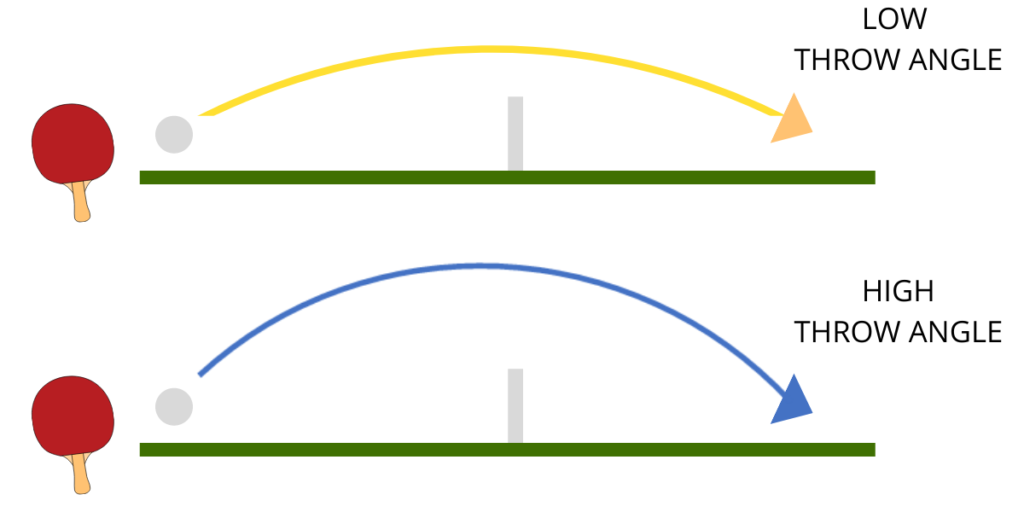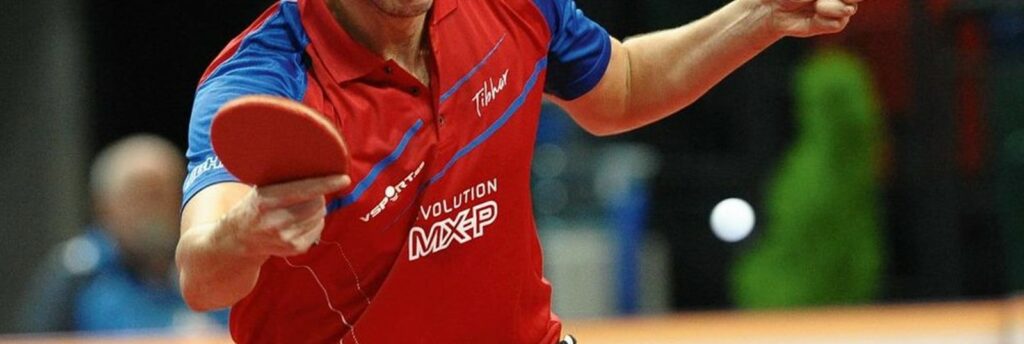There are many different sponge thicknesses available for table tennis rubbers which makes it difficult for players to know whether they need a thicker or a thinner sponge. In this article, I’ll be addressing the effect of rubber/ sponge thickness on:
- Spin
- Throw Angle
- Power and Speed
- Control
The Quick Answer
Table tennis rubbers with thicker sponges are more powerful, generate more spin and have a higher throw angle compared to rubbers with thinner sponge layers. Thicker sponges are good for offensive-styles and looping whereas thinner sponges are useful for blocking and defensive styles of play.
| Thin Rubber and Sponge | Thick Rubber and Sponge |
| Less spin generation | More spin generation |
| Lower throw angle | Higher throw angle |
| Less power and speed | More power and speed |
| Good for blocking | Good for looping |
| Better for backhand | Better for forehand |
| Suits defensive-styles | Suits offensive-styles |
Average Rubber-Sponge Thickness
According to the ITTF, the maximum thickness of the sponge and rubber layer combined must be 4mm thick or less.
Most brands describe the thickness of the rubber by referring only to the sponge layer. For example, Butterfly Tenergy 05 has three different thicknesses: 1.7 mm, 1.9 mm and 2.1 mm. This refers to the thickness of the sponge layer only.
Some brands state that the rubber thickness is “MAX (4 mm)”. This means that the total thickness sponge and rubber layer equals 4 mm.
Take XIOM Vega Pro as an example. This can be purchased in three different thicknesses: 1.8 mm, 2.0 mm and MAX. In each case, the rubber topsheet is 1.8 mm thick. Hence the measurements for each version are:
| XIOM Vega Pro | Rubber Topsheet Thickness | Sponge Layer Thickness | Total Thickness |
| 1.8 mm | 1.8 mm | 1.8 mm | 3.6 mm |
| 2.0 mm | 1.8 mm | 2.0 mm | 3.8 mm |
| MAX | 1.8 mm | 2.2 mm | 4.0 mm |
The terms “rubber thickness” and “sponge thickness” are often used interchangeably. However, it’s usually the sponge thickness that is being referred to. Now let’s discuss the impact it has on speed, spin and control.

Relationship Between Sponge Thickness and Spin
The thicker the sponge layer is, the more spin will be generated on the ball. Thicker sponge layers allow the ball to sink into the paddle more, giving it more dwell time and hence more time to apply spin to the ball. A thinner sponge decreases this dwell time so there is a limit to how much spin can be applied.
It’s a little more complicated though because it also depends on how hard you hit the ball. The harder you hit the ball, the more it will sink into the sponge layer and hence, the more spin you will create. If you hit the ball with less force, the benefit of having a thicker sponge will not really come into play.
This is why you often see professionals using max thickness rubbers for looping. These players have a more powerful stroke and when combined with a thicker sponge, they receive the greatest benefit in terms of spin.
Effect on Throw Angle
The thickness of the sponge affects the throw angle of the ball. The throw angle refers to the angle at which the ball leaves the rubber after it is struck. A high throw angle means the ball will go higher into the air, whereas a low throw angle means that the ball will travel with a flatter trajectory.
Thinner rubbers have a tendency to “bottom out”, particularly if they are softer. This means that the throw angle is very low.
Sometimes a low throw angle is useful for blocking and flat-hitting and can make it harder for the other player to counter. However, rubbers with a lower throw angle have a smaller margin of error to get the ball over the net. High throw angles are often preferred by players who like to loop as the ball will be lifted higher and travel in an arc.
Check out my complete guide to throw angles to learn everything you need to know.

How Does Sponge Thickness Affect Speed?
Table tennis rubbers with thicker sponges are more powerful. This means that a paddle with a thicker sponge layer will make the ball move faster when struck with the same force compared to a paddle with a thinner sponge layer.
When the ball hits the rubber, it causes the sponge layer to compress. The ball is then catapulted off the rubber when the sponge rebounds. The thicker the sponge is, the more it can be compressed and hence the more energy it stores.
This is why offensive players who want a powerful rubber often choose the max thickness available. This will help them to make the ball generate more speed and make it harder for the opponent to return the ball.

Sponge Thickness and Control
This is where the big debate comes in. Thinner sponges are often described as being easier to control. However, this is not an entirely helpful statement.
The problem is that “control” is a very subjective thing. Some defensive players will like to slow the game down and use a rubber which is slower and less sensitive to incoming spin. In this case, a thinner rubber/ sponge will be more useful.
On the other hand, if you like to apply spin and your stroke requires a rubber with a higher throw angle, then a thicker sponge is more useful as otherwise you may struggle to get the ball over the net more. Thinner sponges have the tendency to “bottom out” more, particularly if they are soft. Hence, for some players then can offer less “control”.
If you are a beginner, it’s a good idea to stay with a fairly moderate sponge thickness. Having a very thick sponge may make the ball more difficult to control since it has more power and speed. On the other hand, having a thin sponge will make it harder to apply spin.
Going for around a 1.8 mm thickness is a good bet if you are unsure what to try. However, it’s best to speak to your coach as they will know your style more and be able to give you some more tailored advice.
Backhand vs Forehand
It’s not uncommon to select a thicker sponge on the forehand side and thinner sponge on the backhand side of the paddle.
The thinking behind this is that the thicker sponge on the forehand will be useful for adding spin and speed for more offensive playing. Most players feel more comfortable on the forehand so the extra speed shouldn’t have an real drawbacks in terms of control, but it will make looping more effective.
The thinner sponge on the backhand will slow down the game slightly and is useful for blocking. Thinner sponges are more forgiving so can be useful when you are out of position and need to be more defensive.
